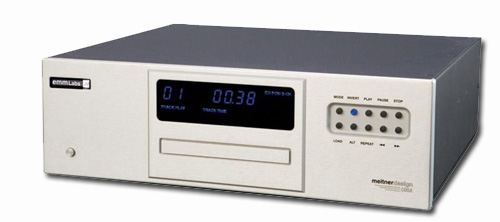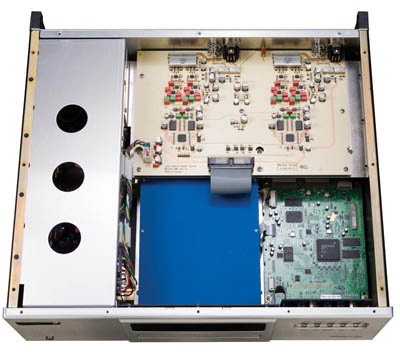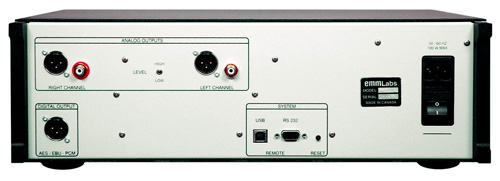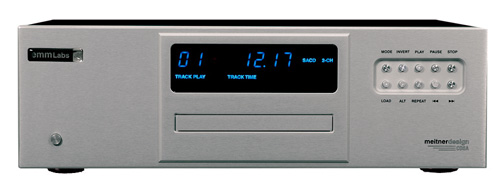
You are reading the older HTML site
Positive Feedback ISSUE
may/june 2007
emm labs
CDSA SE CD/SACD player
as reviewed by Dave Clark

|
The EMM Labs CDSA SE one-box SACD/CD player. This is the latest and greatest from digital/audio brainiac genius Ed Meitner. Featuring all that he knows to date with respect to how to get the bits to sound like music, the CDSA SE features the best of his two-box machines in one easy to use unit. I remember many a CES where I would ask Ed to please make a one-box machine that sounds like his two-box units with none of the stuff that a typical guy needs—the preamp, switching, clocks, and whatnot. Ed, make us guys a simple version that sounds just as good… and do it for less money. Ed would smile and say he would think about it… well the day has come…
The CDSA takes Redbook CDs (the 44.1kHz signal) and upsamples to 5.6448MHz. This is accomplished by Meitner Digital Audio Translator (MDAT) signal processing technology. To paraphrase from the EMM site …"The MDAT addresses the digital signal as a series of sine waves—as is standard convention—the MDAT-equipped CDSA SE processes (and upsamples CD audio to DSD for conversion to analog) by dynamically adapting to the transient nature of the musical signal. In this way, the CDSA SE is utterly unique and singularly able to preserve the phase, frequency and dynamic integrity of the original signal."
CDSA SE also features Ed's own discrete dual differential D-to-A conversion circuit. Nothing off the shelf for EMM, their stuff is pretty much built by them from the ground up. Well, except perhaps the choice of a Phillips drive assembly and various other parts (caps, resistors and such), but even with that, they use their own aerospace-grade composite laminate circuit boards, featuring:
Copper traces are microscopically smooth on top and bottom, significantly reducing skin effect issues
Naturally damped sandwich construction offers superior strength and vibration resistance
Lower dielectric losses and superior heat conduction ensure a more uniform temperature gradient across the circuitry, increasing stability and longevity.
Ergonomically the player is pretty much like Ed the man… straightforward and to the point. Ed is a nice guy, but he is a straight talker, as is the CDSA SE. The CDSA SE is not going to win any design awards, but what you get is a simple and undemanding case that is a bit larger than the usual black-ish box with buttons. Offering the typical controls, the player is quite simple to use, with a few caveats. One the Phase option is not as clear-cut as one would like to see on a player of this caliber and price. The manual is a bit vague as to how it is to be set (best?), so a few emails and phone calls with EMM support informed me that when the Phase light is lit blue, it means that the CDSA SE is reversing (or correcting for, depending on how you want to read the matter) how the disc or track was recorded. When not lit (off), the CDSA SE is just playing the disc as it is… no correction or reversal… meaning au natural… though that might not be the best setting. A bit confusing, but I do find things to generally sound better when set to be corrected or reversed—the light being lit that is… which means the CDSA SE is set to the opposite of normal…which is assuming normal is correct… or is it correct to be normal? Ah, the phase of it all! The truth is, set it to whatever sounds best. After all, with multi-tracking/mixing/mic'ing, there is no way one can ever get it set so everything is right. So set it and leave it!

Two, the player likes to see a decent AC set-up. I like the player with the Elrod Signature 2 and the Audio Magic Transcendent AC conditioner set with the first and third switches set to "off" and the second switch set to "on". I am still playing with these filter settings and while the differences are rather subtle, they are still of a musical importance. All "off" is a bit too linear (I do prefer a bit of color or fullness of whatever), just the middle one "on" adds a bit of richness, adding the first on is a bit too closed in…and well… lots to work on to tailor it just right. Try sitting the player on something reasonable too. The Townshend 3D sinks are wonders. I like the CDSA SE up on three BDR #4 cones too. Toss a Shakti stone or three on and under the player and things can become quite magically interesting. Not that the player is a slouch sitting nude, but as a tweaker, well… got to play around and get that last #$!@% touch of performance or step closer towards musical heaven whenever I can!
In reading some of the other reviews and comments by users here and there, I never had any issues with the machine reading a disc and found the CDSA SE to be quite uneventful in operation issues. No glitches, no hassles. Pop in a disc, sit down and the music plays. I would have preferred for the CDSA SE to not play a disc automatically after it is read… hey wait for me to hit play would ya?!... what's the big deal? Anyhow, the CDSA SE is a cinch to use and after a couple of months of use, not a hiccup to be heard… unless it's on the disc.
This is what the CDSA SE is all about. Audibly, this is a very, very linear player, meaning that on paper, it is without a doubt, ruler flat with respect to frequency response. With the CDSA SE nothing jumps out at you screaming for attention—unlike other players. On the other hand, on paper all players are extremely flat to a great degree, and if they do vary, it is rather miniscule and as such should be a moot point with regards to the player's sonic signature. Meaning that if we only look at measurements, then all players should sound alike.

Yet, so many players do not sound alike. For example, having the stellarly musical Cary 306 on hand as my reference (I own it, paid cash) reveals itself, when compared to the CDSA SE, to be a touch richer and warmer than I had previously thought. Not so much lush and colored, but the 306 does not sound as linear as the CDSA SE. It comes across with more color or sonic flavoring to its tonality, which can be construed as being either better or worse. Certainly not a bad thing, just differently good when compared to the EMM CDSA SE's audibly flat linearity.
You know the saying… ah, that is just another slice of the pie? Well the funny things is so much of audio is just that, my slice, your slice, heck which slice is the right slice?
Well naturally, they are both just fine and dandy as each slice contains the same basic stuff. Different yes… perhaps one slice has a tad more or less of that something that we each cherish so much, but they are nothing more than pretty much the same thing. Obviously, people may assume that one slice is better, though usually this is all for some childish intolerant narrow-minded get-a-life reason that just because we each have a different slice, they cannot be equally fine on their own!
Of course, being reasonable people, and if you are reading this, then are we not a reasonable audiophile… one realizes that there is no one right way to make music—we each have our own idea of what is what… the absolute truth is only an absolute in that there is not absolute truth. Truth is in the eye of the beholder… my truth may or may not be yours and vice verse, so go have a brew and let's get on with it.
Which takes me back to the EMM CDSA SE …it makes music, but in a way that is different than that of the Cary 306 and any other player I have heard here. Like I said it is very linear, but it is not the least bit bleached, stripped-down sonically, threadbare, white-ish, analytically over the top, ruthlessly revealing, upfront, the antithesis of musical… yadda, yadda. All the stuff that one equates with being ruler flat it ain't. This linearity offers the listener a sonic character that is quite beguiling. The CDSA SE has incredible slam and dynamics that propels the music in way that the Cary tries to accomplish (hey, it's a close second, but still behind the EMM), but it is not a forward or aggressive player. It presents the music in a very natural way.
The soundstage tends to fall from the front of the speakers towards and back, as opposed to the more out into the room Cary 306. The EMM CDSA SE is not as 3-D as the Cary (though it is to a great degree 3-D), nor does the soundstage become as big and wide as that of the Cary. It is not a deal killer, just a perspective from another seat in the house.

Bass is very viscerally deep and authoritative with a tactile control and punch for any bass freak to get their freak-on. The mids are well balanced within the sonic tapestry being neither overly rich and warm or recessed and threadbare. Just a nice presence and delineation of voices and such, so that they come across as well fleshed-out and as believable as one can get from silver discs. Palpable presence comes to mind… almost perfect with not much if anything to complain about, though compared to the Cary the EMM presents the vocals with an ever so slight digital presence … a pinch of grain perhaps? Maybe, as the Cary sounds a bit smoother on female vocals, being just that more liquid and golden.
So on vocals, the EMM is not as real-like as the Cary, but this is open to interpretation. The Cary may be adding too much chest or head (or color) to the singer covering over what is on the disc. Then again, the EMM may not be adding enough of whatever to what is on the disc, in that it is not coloring the sound. On the other hand, maybe is it adding something of its own—a degree of hash or whatever—or maybe is it revealing too much of what is on the disc…? No doubt, this all depends on what you are after… in absolute terms, the EMM takes a few pounds off the singer, while the Cary adds a few pounds. Hey, sometimes we can to go either way and still be quite happy. For me, on most discs I prefer the Cary, but on others the EMM is the choice. Most of this is more an issue of the way the disc was recorded… so it all boils down to your music and flavor or seasoning preferences. Either is a winner! Read this for more on what may be happening here.
The treble is presented in a natural and not-spot-lit way. Metal sounds like metal and not something from the five and dime store. No glare or grit or that sparkly sparkle that drives you batty as the highs pierce your inner sanctum or jump out at you screaming for attention. Being linear, this is where it all can get real nasty, but the CDSA SE holds it together sounding very well balanced and in the end, effortlessly musical. The player's linearity creates an assumption of it being a more revealing player than the competition—getting all that subtle tinkles and sprinkles that one thought was hidden on their discs to now being audibly audible as never before. But, I think that one just hears more more because there is less coloration, or an absence of whatever non-linearity another player has in its character. That is, this coloration had previously obfuscated or hidden stuff from the listener, but with the EMM it is now readily apparent in a natural way.
In comparing this attribute using familiar music on either player, one will hear the same details revealed in equal fashion, the only difference being not so much their emphasis (hearing more or less of it within the music), but their role or placement within the character of the player and its presentation of the music. The EMM appears to reveal more details as it is as linear as the proverbial razor's edge, and as such, has less coloration across the sonic palette, therefore things sound more resolved and present. The Cary presents, to a certain degree, a coloration or non-linearity across the sonic spectrum, so even though it is equally as resolving, that tinkly stuff has to some degree a sonic sameness as the rest of the tapestry. It stands out less from the rest, but is still there being resolved resolutely. Which is right, is up to you. I can appreciate both and find value in either presentation. Some discs benefit from one, and die a quick death with the other. Ditto my frame of mind at the time of listening to this or that… or what I had been drinking.
Of course there is more to resolution than hearing all the tinkly stuff…. There is hearing more music in the sense of pace, dynamics, rhythm …the stuff that makes listening to music fun and engaging. The EMM CDSA SE gets it right without making the experience tiring and over the top. It is an amazing player that communicates all the feeling and whatnot in the recording, allowing one to react as any nudnik would—you get up and dance like the geek we were born to be!
So what does all this mean? It means that Ed has addressed the digital nasties that get in the way and screw with the music, meaning discs don't sound like bright, overly washed-out crap—digital's reputation. Well, that reputation goes south real fast with the EMM CDSA SE. Nah, it is fine, quite fine indeed—on Rebook or SACD. Like I said before, it is not as tonally rich or full as the Cary 306 is (say around the mid bass area where it has more sway or character in the trunk), but I have had enough people here to establish that this is more of a different strokes for different folks sort of thing. Some of the listeners have gone gaga over the EMM CDSA SE claiming that that is what it is all about and some have gone gaga over the Cary 306 saying that that is what it is all about. Ying and Yang….
Carol is nuts over the EMM finding her music best served straight with no chaser. The EMM CDSA SE gets it right for her with its dynamics and slam. No added whatever for her, her music is served pure and clean… mean and nasty. Not that the EMM CDSA SE is mean and nasty, but if your music is, then it will be… but it won't be what it ain't.
I will admit that 99% of the review is based on Redbook as there is not much on SACD that fits our tastes. I am getting more into SACD via classical recommendations from Mark Wagner, so consider my comments on what the player does with good old 16/44.1!
Complaints? Well, I have heard that the player does not have the look or feel of a $10k machine—though I am not so sure what that means, as this is really up to the buyer to discern what meets that requirement and besides what should a $10k machine look like, let alone feel like? However, I guess it could weigh more and have more stuff to muck it up. It can be a bit too linear for those who want a more colorful or non-linear sound. It plays discs without you asking. It has a plastic remote that lights up in the dark. The manual is rather Spartan and really only tells you what you need to know… put the disc here, press that, listen till it is done, now press this and take the disc out, don't put it in the tub, and it needs to be plugged in to work. It might not sound as musical or whatever when compared to something else, but one can say that about anything or everything for anyone and everyone at anytime.
Could I live with the EMM CDSA SE? Oh, most definitely. Am I going to sell the Cary 306? Uh…no. Like 'em both too much let either of them go. Both are too right in their own way… just a different right. Best to say that the EMM is like the best of solid-state and that the Cary is like the best of tube. Not that this is to be a 306 versus the CDSA SE review (easy to compare as they are both wonderful and similarly priced at the top), nor is this a "what is the best player for me to buy" sort of thing. Each is a stellar machine with their own unique features; the 306 allows for user-selected upsampling—both inputs and outputs—and offers HDCD. The CDSA SE does not allow for user-selected upsampling as it takes Redbook and runs the gaboogers out of it (up to the nether regions of to 5.6448MHz) and is a straightforward machine—plop in a disc and hit play. Both play SACD. Both feature…. Ahhh, get the EMM—or the Cary if you lean that way—and enjoy your music. Highly, HIGHLY highly, highly recommended. The EMM CDSA SE is a killer machine with little, if anything—like nadda, zilch—to deter the music lover from being happy! Dave Clark
CDSA SE SACD/CD player
Retail: $9995
EMM Labs
web address:
www.emmlabs.com
